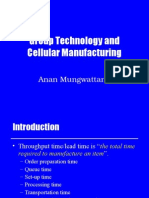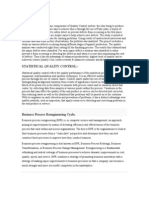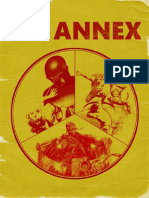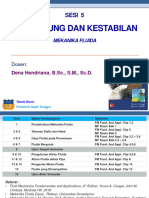0 ratings0% found this document useful (0 votes)
103 viewsJust in Time Manufacturing System: A Special Topic in Cost Accounting 2
Just in Time Manufacturing System: A Special Topic in Cost Accounting 2
Uploaded by
Venn Bacus RabadonThis document discusses a presentation on Just-In-Time manufacturing systems for a cost accounting class. It defines JIT, its objectives and philosophy. It also describes Kanban systems and compares traditional and JIT costing systems. Finally, it discusses value-added and non-value added activities in manufacturing. The presentation was created by four students for a class at the University of San Carlos in Cebu, Philippines.
Copyright:
© All Rights Reserved
Available Formats
Download as DOCX, PDF, TXT or read online from Scribd
Just in Time Manufacturing System: A Special Topic in Cost Accounting 2
Just in Time Manufacturing System: A Special Topic in Cost Accounting 2
Uploaded by
Venn Bacus Rabadon0 ratings0% found this document useful (0 votes)
103 views12 pagesThis document discusses a presentation on Just-In-Time manufacturing systems for a cost accounting class. It defines JIT, its objectives and philosophy. It also describes Kanban systems and compares traditional and JIT costing systems. Finally, it discusses value-added and non-value added activities in manufacturing. The presentation was created by four students for a class at the University of San Carlos in Cebu, Philippines.
Original Description:
e
Original Title
ac 512
Copyright
© © All Rights Reserved
Available Formats
DOCX, PDF, TXT or read online from Scribd
Share this document
Did you find this document useful?
Is this content inappropriate?
This document discusses a presentation on Just-In-Time manufacturing systems for a cost accounting class. It defines JIT, its objectives and philosophy. It also describes Kanban systems and compares traditional and JIT costing systems. Finally, it discusses value-added and non-value added activities in manufacturing. The presentation was created by four students for a class at the University of San Carlos in Cebu, Philippines.
Copyright:
© All Rights Reserved
Available Formats
Download as DOCX, PDF, TXT or read online from Scribd
Download as docx, pdf, or txt
0 ratings0% found this document useful (0 votes)
103 views12 pagesJust in Time Manufacturing System: A Special Topic in Cost Accounting 2
Just in Time Manufacturing System: A Special Topic in Cost Accounting 2
Uploaded by
Venn Bacus RabadonThis document discusses a presentation on Just-In-Time manufacturing systems for a cost accounting class. It defines JIT, its objectives and philosophy. It also describes Kanban systems and compares traditional and JIT costing systems. Finally, it discusses value-added and non-value added activities in manufacturing. The presentation was created by four students for a class at the University of San Carlos in Cebu, Philippines.
Copyright:
© All Rights Reserved
Available Formats
Download as DOCX, PDF, TXT or read online from Scribd
Download as docx, pdf, or txt
You are on page 1of 12
School of Business and Economics
University of San Carlos
P. Del Rosario St., Cebu City 6000
Cebu, Philippines
Just in Time Manufacturing System
A Special Topic in Cost Accounting 2
In partial fulfillment of the requirements for the course
AC 512: Cost Accounting, Part 2
Presented by
BURGAS, JHENNEL
CASINO, EMIRUFF OLEGARIO
NACUA, LORLEE
YAUNA, MICHAEL BENEDICT
MWF 7:30 8:30 p.m.
September 30, 2011
1
JUST IN TIME MANUFACTURING SYSTEM
What is Just in Time Manufacturing or JIT?
A corporate system designed to produce output within the minimum lead time and at
the lowest total cost by continuously identifying and eliminating all forms of corporate
waste and variance.
It is a production and inventory control system in which materials are purchased and
units are produced only as needed to meet actual customer demand
A corporate strategy and a philosophy
The focus of JIT is to eliminate variance & waste
Objectives of JIT
Produce only the products the customer wants.
Produce products only at the rate that the customer wants them.
Produce with perfect quality
Produce with minimum lead time.
Produce products with only those features the customer wants.
Produce with no waste of labor, material or equipment -- every movement must have
a purpose so that there is zero idle inventory.
Produce with methods that allow for the development of people
Philosophy of JIT
JIT means getting the right quantity of goods at the right place and right time
All waste must be eliminated- non value items
Broad view: that entire organization must focus on serving customers
JIT is built on simplicity- the simpler the better
Focuses on improving every operation- Kaizen
Install simple visible control systems
Flexibility to produce different models/features
The main benefits of just in time manufacturing system are the following:
1. Funds that were tied up in inventories can be used elsewhere.
2. Areas previously used, to store inventories can be used for other more productive uses.
2
3. Throughput time is reduced, resulting in greater potential output and quicker response to
customers.
4. Defect rates are reduced, resulting in less waste and greater customer satisfaction.
Disadvantages of using the just in time system:
1. Implementing thorough JIT procedures can involve a major overhaul of your business
systems- it may be difficult and expensive to introduce.
2. JIT manufacturing also opens businesses to a number of risks, notably those associated
with your supply chain. With no stocks to fall back on, a minor disruption in supplies to
your business from just one supplier could force production to cease at very short notice.
KANBAN SYSTEM
A Kanban system is a means to achieve just in time (JIT) production. It works on the basis that
each process on a production line pulls just the number and type of components the process
requires, at just the right time. The mechanism used is a Kanban card. This is usually a physical
card but other devices can be used Two types of such cards are usually used.
KANBANS simplify day to day flexibility, and changes to the production schedule need only to
be given to the final assembly process and will then automatically work their way back up the
line. Kanban systems can be tightened by removing cards or by reducing the number of parts
on pallet. The effect will be to speed the flow through the process and hence reduce lead time.
However it also makes the system more vulnerable to breakdowns and other causes of
dislocation. By identifying the areas within the line that are causing disruption, efforts can be
made to improve them. Thus the overall efficiency of the line is raised by tackling the key points.
Advantages of KANBAN:
Low costs associated with the transfer of information
Provides quick response to changes
Delegates responsibility to line workers
It is a simple technique not involving computers so its cost is low.
Lead times are reduced.
3
Disadvantages of KANBAN:
It is less effective in shared-resource situations. Suppose the upstream station made
several parts. Then a request to make more of the part needed by the downstream
station will have to wait if other parts have to be made. A buffer is needed to ensure the
downstream station doesn't run out meanwhile. And, because each part needs a
separate signaling card, the system becomes more complex than if the resources were
dedicated.
Surges in mix or demand cause problems because KANBAN assumes stable repetitive
production plans. It is less suited to industries where mix and volumes fluctuate.
KANBAN in itself doesn't eliminate variability, so unpredictable and lengthy down times
could disrupt the system; poor quality in terms of scrap and rework also affect its good
functioning.
KANBAN systems are not suited for manufacturing environments with short production
runs, highly variable product demand, poor quality products, and a multitude of product
types.
A breakdown in the KANBAN system can result in the entire line shutting down.
The throughput of a KANBAN system is not managed but is instead a result of controlled
WIP and known cycle times.
TRADITIONAL COSTING SYSTEM vs. JIT COSTING SYSTEM
Concept Traditional Costing
JIT
(Lean Enterprise)
Original purpose
Inventory valuation and matching
& overall profit
Reduce waste & increase
efficiency
Expanded purpose
Management control - variance
analysis
System philosophy of Continuous
improvement
Short or long run
orientation
Short run emphasis with long run
implications
Long run improvement
Main focus or concept
Production and value added by
production departments
The whole system:
interdependence, cooperation &
synergy
4
Production control or
emphasis
Push system with emphasis on
labor efficiency & production
volume
Pull system using kanban
authorizations to produce
Overhead cost
allocation emphasis &
drivers
Allocate using production volume
based drivers
Assign costs based on cycle time
in the cells
Product costs
accuracy
Not accurate - distorted Fairly accurate
Inventory levels High Minimum to zero
Waste Price and quantity variances Emphasis on eliminating
Capacity focus
Labor & machine utilization,
production volume variances
Measured by cycle time.
Emphasis on balancing capacity &
the flow of work
Quality of conformance Inspect to find spoilage Quality at the source, Jidoka
Effect producing
excess inventory has
on profit
Increases profit
Using throughput costing it
decreases profit
Performance
Measurements
Mainly financial measurements,
i.e., variances, Net income and
return on investment
Non-financial measurements such
as cycle time, on time delivery,
quality (% defects) inventory turns
as well as unit costs
VALUE ADDED & NON-VALUE ADDED ACTIVITITIES
Only when you have identified your non-value added activities in your process can you reduce
or eliminate them. During this cycle time analysis one identifies and eliminates bottlenecks,
decreases wait or queue time, increase process frequency, simplifies the process, allows more
time for conducting value added work.
Value adding activity
Providing worth or merit to an activity as defined by the customer. Activities must be performed
to meet customers CTQs. Actions are value added if the customer cares, if something is
5
physically changing for the best and you do the step right the first time. Value added activities
essentially change the product or service and the customer is willing to pay for them.
An activity is considered value adding if it satisfies all three of these requirements: (1) the
customer is willing to pay for the process or activity, (2) the process or activity physically
changes or transforms the process or activity, and (3) the process or activity is performed
correctly the first time its undertaken. These activities generate a positive return on investment
and resources and cannot be eliminated without impairing the production process.
Non-value adding activity
Actions or activities in a process, procedure, or service that do not add value or conformance to
the external customer, (customer requirements), or company and do not meet all criteria
for value-adding which includes rework, inspection, control, and the like. These are usually not
profitable activities, for example scrap. One major goal of any six sigma endeavor is to reduce
any activity that does not add value.
Some non-value adding activities are necessary and cannot be avoided. One needs to look at
these activities to see if they could be included in value adding activities or eliminated which
should aid to reduce the cost and get a better return on investment.
Non-value added activities typically comprise 90% of total product cycle time. These should be
eliminated, reduced and simplified.
Some examples of non-value added activities:
Bottle necks on production lines
Cant find things or lost or misplaced material or equipment. For utensils and
equipment use shadow boards (place of everything and everything in its place)
Mistakes like using expired material
Too much sampling and testing
Unorganized work areas and lack of housekeeping
Unavailability of information
Too much travel distance/time due to poor lay out on shop floor
Reworks and sorting defect material
Not doing things right the first time
6
Unnecessary equipment stoppages or manufacturing downtime
Lack of materials or manpower hindering operation f low
Unlabelled or unidentifiable material
Running out of consumables (order in advance)
Too long or insufficient set up times
Continuous state of performing emergency fixes to problems
Ineffective or lack of planning
Generating too much waste and scrap material
Human non-value added activities are mistakes, forgetfulness, poor communication,
indecisiveness, no authority to take action
Untapped personnel or not using peoples expertise
Over processing
Over production and holding too much inventory Unscheduled machine maintenance
or repairs
Transportation problems
Incorrect storage conditions where FIFO (First in First Out). Point of Use storage
might eliminate warehousing and non-value added handling or waiting time
Using ineffective equipment e.g. equipment not intended for use
Unskilled and untrained personnel
Queue or waiting
Unreliable suppliers
Unnecessary machine change over
No safety stock
Producing incorrect yields
TIMWOOD seven wastes: Transportation, Inventory, Movement, Waiting, Over
processing, Overproduction, Defects.
4 MEASURES OF JUST IN TIME SYSTEM PROCESS PERFORMANCE
I. Manufacturing Cycle Efficiency
Manufacturing Cycle Efficiency is value added time as a percentage of throughput time or value
add (VA) time divided by non-value add(NVA) time. That is, in the entirety of a process flow or
value stream flow, the total of value added time divided by the total of non-value added time.
7
Basically this breaks down to the time spent actually working on the product divided by the time
spent working on the product, time spent on inspecting the product, time spent on moving the
product and time a product spend waiting to be worked on.
Formula:
MCE = Value-added time / Throughput time
If the MCE is less than 1, then non-value added time is present in the production process. An
MCE of 0.5, for example, would mean that half of the total production time consisted of
inspection, moving, and similar non-value-added activities. In many manufacturing companies, it
is less than 0.1 (10%), which means that 90% of the time a unit is in process is spent on
activities that do not add value to the product. By monitoring the MCE, companies are able to
reduce non-value-added activities and thus get products into the hands of customers more
quickly and at a lower cost.
Example
Calculation of Manufacturing Cycle Efficiency:
Novex Company keeps careful track of the time relating to orders and their production. During
the most recent quarter, the following average times were recorded for each unit or order:
Wait time 17.0
Inspection time 0.4
Process time 2.0
Move time 0.6
Queue time 5.0
Goods are shipped as soon as production is completed.
MCE = Value-added time / Throughput time
MCE = 2.0 days* / 8.0 days**
= 0.25
*Only process time (2.0 days) represents value-added time
8
**Throughput time = Process time + Inspection time + move time + Queue time
= 2.0 days + 0.4 days + 0.6 days + 5.0 days
= 8.0 days
II. Delivery Cycle Time
The amount of time from when an order is received from a customer to when the completed
order is shipped is called delivery cycle time. This time is clearly a key concern to many
customers, who would like the delivery cycle time to be as short as possible. Cutting the delivery
cycle time may give a company a key competitive advantage - and may be necessary for
survival. Consequently, many companies would include this performance measure on their
balanced scorecard.
Delivery Cycle Time and Throughput (Manufacturing Cycle) Time
Formula:
Delivery Cycle Time = Wait time + Throughput time
Calculation of Delivery Cycle Time:
Novex Company keeps careful track of the time relating to orders and their production. During
the most recent quarter, the following average times were recorded for each unit or order:
9
Wait time 17.0
Inspection time 0.4
Process time 2.0
Move time 0.6
Queue time 5.0
Goods are shipped as soon as production is completed.
Delivery Cycle Efficiency = Wait time + Throughput time
= 17.0 days + 8.0 days*
= 25.0 days
*Throughput time = Process time + Inspection time + move time + Queue time
= 2.0 days + 0.4 days + 0.6 days + 5.0 days
= 8.0 days
III. Throughput (Manufacturing Cycle) Time
The amount of time required to turn raw materials into completed product is called throughput
time, or Manufacturing cycle time.
The throughput time or manufacturing cycle time is made up of process time, inspection time,
move time, and queue time. Process time is the amount of time work is actually done on the
product. Inspection time is the amount of time spent ensuring that the product is not defective.
Move time is the time required to move materials or partially completed products from
workstation to workstation. Queue time is the amount of time a product spends waiting to be
worked on, to be moved, to be inspected or to be shipped.
Only one of these four activities adds value to the product - process time. The other three
activities - inspecting, moving, and queuing - add no value to the product and should be
eliminated as much as possible.
Formula:
Throughput time = Process time + Inspection time + move time + Queue time
10
Calculation of Throughput Time or Manufacturing Cycle Time:
Novex Company keeps careful track of the time relating to orders and their production. During
the most recent quarter, the following average times were recorded for each unit or order:
Wait time 17.0
Inspection time 0.4
Process time 2.0
Move time 0.6
Queue time 5.0
Goods are shipped as soon as production is completed.
Throughput time = Process time + Inspection time + move time + Queue time
= 2.0 days + 0.4 days + 0.6 days + 5.0 days
= 8.0 days
IV. Velocity
There is an important and direct relationship between the size of WIP and the speed of
production. If the rate of output is maintained while the number of units in process is cut in half,
then the speed of the system has been doubled. As long as the rate of output is held constant,
reducing the number of units in process and increasing the speed of the system are one and the
same. The speed which units or tasks are processed in a system is called the velocity and is
inversely related to the throughput time.
A strategic benefit of increased velocity is the reduced time needed to fill production orders.
Velocity improvement can be extended forward to finished goods inventory and shipping. The
result is a shorter total lead time for responding to any change in customer tastes or opportunity
for a new product or product variation. Reducing cycle time or increasing velocity means
reducing cost and increasing competitiveness.
An increase in velocity results in the reduction of throughput time or the manufacturing cycle
time that entails reducing duration and costs of set-up. Suppose the annual carrying cost is 25%
11
variable production cost and the variable cost of average WEP is $200,000. With JIT, the
company would be able to double the velocity by cutting average batch size in half. Average
WIP will be reduced by half, producing savings of $25,000 (25% x $200,000) in annual carrying
cost.
PROCESS PRODUCTIVITY AND QUALITY YIELD
Process productivity refers to the total units started during the period divided by the value
added processing time while process quantity yield is the proportion of goods units resulting
from activities.
You might also like
- Schneider Production System: The Global Specialist in Energy ManagementDocument16 pagesSchneider Production System: The Global Specialist in Energy ManagementAmrNo ratings yet
- 2008 A Leanness Measure of Manufacturing Systems For Quantifying Impacts of Lean InitiativesDocument19 pages2008 A Leanness Measure of Manufacturing Systems For Quantifying Impacts of Lean Initiativesteany_ds9790No ratings yet
- Accounting For Disbursements and Related TransactionsDocument12 pagesAccounting For Disbursements and Related TransactionsVenn Bacus Rabadon100% (10)
- Commodity MoneyDocument28 pagesCommodity MoneyVenn Bacus RabadonNo ratings yet
- Software Development Project Manager in San Diego or Orange County California ResumeDocument2 pagesSoftware Development Project Manager in San Diego or Orange County California ResumeTerry MillerNo ratings yet
- Production and Costs: MP TP Units of LabourDocument11 pagesProduction and Costs: MP TP Units of LabourJoep Minderhoud100% (1)
- Senior Manufacturing EngineerDocument4 pagesSenior Manufacturing Engineerapi-78878905No ratings yet
- Production MGT Design For Manufacture and AssemblyDocument14 pagesProduction MGT Design For Manufacture and AssemblybshariNo ratings yet
- Lean Case StudyDocument22 pagesLean Case Studyfcleong69No ratings yet
- The Cost of Production - Chapter 7Document18 pagesThe Cost of Production - Chapter 7rajesh shekarNo ratings yet
- Honeywell Young Innovator - BrochureDocument8 pagesHoneywell Young Innovator - BrochurevamshiballikondaNo ratings yet
- Kirandeep - JIT & LeanDocument22 pagesKirandeep - JIT & LeanAmarjeet Singh RanaNo ratings yet
- Standard Operating Procedure For Procurement Personell PDFDocument24 pagesStandard Operating Procedure For Procurement Personell PDFMahabubnubNo ratings yet
- Sales and Distribution ManagementDocument10 pagesSales and Distribution Management7figureNo ratings yet
- T5.Principles of Quality Engineering in Design and Manufacturing - Part IDocument33 pagesT5.Principles of Quality Engineering in Design and Manufacturing - Part IAl Aiden100% (1)
- Work Measurement Knowledge SharingDocument40 pagesWork Measurement Knowledge Sharingdinhlap237No ratings yet
- SDMDocument16 pagesSDMSam LordNo ratings yet
- Improvement of Manufacturing ProcessesDocument9 pagesImprovement of Manufacturing ProcessesNavnath TamhaneNo ratings yet
- Injection Molding: 2.810 Fall 2002 Professor Tim GutowskiDocument42 pagesInjection Molding: 2.810 Fall 2002 Professor Tim GutowskiSree Raj100% (1)
- Schneider Electric - R&D Job Description - 2024 BatchDocument32 pagesSchneider Electric - R&D Job Description - 2024 BatchTejeswini KrishnanNo ratings yet
- Traditipn Production Planning and ControlDocument16 pagesTraditipn Production Planning and ControlpaulineNo ratings yet
- Balanced Scorecard and Hoshin KanriDocument6 pagesBalanced Scorecard and Hoshin KanriAntonio CervantesNo ratings yet
- Cellular ManufacturingDocument48 pagesCellular Manufacturingcharles ondiekiNo ratings yet
- Module 3 - Production ControlDocument55 pagesModule 3 - Production ControlRahul LoharNo ratings yet
- 02-1-Development Process-PDD PDFDocument17 pages02-1-Development Process-PDD PDFChandan MishraNo ratings yet
- Agile Manufacturing MS IEMDocument21 pagesAgile Manufacturing MS IEMUsman RazaNo ratings yet
- Kaizen Event Implementation Manual by Mika, GeoffreyDocument169 pagesKaizen Event Implementation Manual by Mika, GeoffreyEduardo favelaNo ratings yet
- The Changing World of Validating Manufacturing ProcessesDocument24 pagesThe Changing World of Validating Manufacturing ProcessesJuan RosNo ratings yet
- Digital Panel MeterDocument11 pagesDigital Panel Meterkbl11794No ratings yet
- Engineering Economics: Modern Design ProcessDocument10 pagesEngineering Economics: Modern Design ProcessBenny BasitNo ratings yet
- Resume - Krishna RaypureddyDocument6 pagesResume - Krishna Raypureddykris_krNo ratings yet
- Group Technology and Cellular Manufacturing: Anan MungwattanaDocument89 pagesGroup Technology and Cellular Manufacturing: Anan MungwattanaNarathorn PummarinNo ratings yet
- (Case Study) Utilization of DFMA To TRIZ MethodologyDocument11 pages(Case Study) Utilization of DFMA To TRIZ MethodologyJosh PeraltaNo ratings yet
- Door KnobDocument18 pagesDoor KnobVasda VinciNo ratings yet
- SOP-FES-10 Robbery Theft Vandalism Fire Violent CustomersDocument5 pagesSOP-FES-10 Robbery Theft Vandalism Fire Violent CustomersvikramNo ratings yet
- Waste Reduction by Lean Construction - Office Building Case StudyDocument11 pagesWaste Reduction by Lean Construction - Office Building Case StudyLucero Bereche BNo ratings yet
- Poka YokeDocument2 pagesPoka YokeKishlaiNo ratings yet
- Design For ManufacturabilityDocument27 pagesDesign For Manufacturabilitynitouch3564No ratings yet
- INN Product Design and DevelopmentDocument23 pagesINN Product Design and Developmenthsvzsd44100% (1)
- Storing DHMControlDocument11 pagesStoring DHMControlOm SinghNo ratings yet
- Design Process For PlasticDocument43 pagesDesign Process For PlasticAmolPagdalNo ratings yet
- Process Engineer Lean Manufacturing in Freeport TX Resume Douglas WilkinsDocument2 pagesProcess Engineer Lean Manufacturing in Freeport TX Resume Douglas WilkinsDouglasWilkinsNo ratings yet
- 3M LeanDocument21 pages3M LeanNAMAN GUPTANo ratings yet
- 3.a Case Study Application of Six Sigma Methodology in A Small and Medium-Sized Manufacturing Enterprise.Document13 pages3.a Case Study Application of Six Sigma Methodology in A Small and Medium-Sized Manufacturing Enterprise.Robin MariaNo ratings yet
- PLC - Operation StrategyDocument19 pagesPLC - Operation Strategyravi alwaysNo ratings yet
- Manual Mould and Tool SteelsDocument38 pagesManual Mould and Tool Steelsodhiles1No ratings yet
- Productivity Improvement Through Lean ManufacturingDocument6 pagesProductivity Improvement Through Lean ManufacturingmanikandaprabuNo ratings yet
- Cellular Manufacturing: and Facilities LayoutDocument64 pagesCellular Manufacturing: and Facilities LayoutMochamad AzizNo ratings yet
- Presentation Total Productive Maintenance (TPM)Document14 pagesPresentation Total Productive Maintenance (TPM)jaanus143No ratings yet
- A Model To Reduce Machine Changeover Time and ImproveDocument23 pagesA Model To Reduce Machine Changeover Time and ImproveDe JanNo ratings yet
- (2004) GUNASEKARAN Et Al - Framework For Supply Chain Performance MeasurementDocument15 pages(2004) GUNASEKARAN Et Al - Framework For Supply Chain Performance MeasurementfranksmNo ratings yet
- Wave Solder TaguchiDocument6 pagesWave Solder TaguchivictoreaNo ratings yet
- Ceramic Injection MouldingDocument8 pagesCeramic Injection Mouldingsaritha339No ratings yet
- Lesson 2 - PRODUCTS, PROCESS AND SCHEDULE DESIGNDocument30 pagesLesson 2 - PRODUCTS, PROCESS AND SCHEDULE DESIGNMazey AustriaNo ratings yet
- 10 Supplier Sampling GEN IP1001 10-11-13Document8 pages10 Supplier Sampling GEN IP1001 10-11-13budi_alamsyahNo ratings yet
- Systems and Quality Day2Document86 pagesSystems and Quality Day2Prof Daniel KitawNo ratings yet
- Kanban SystemDocument4 pagesKanban Systemvvns4519888No ratings yet
- Design For Manufacture and Assembly FinalDocument14 pagesDesign For Manufacture and Assembly FinalSushrut SulekarNo ratings yet
- The Lean Manufacturing Tools in Polish FoundriesDocument5 pagesThe Lean Manufacturing Tools in Polish Foundrieskevin21790No ratings yet
- 2023 Manufacturing EbookDocument54 pages2023 Manufacturing EbookRicky ChangNo ratings yet
- Anagerial Ccounting: An OverviewDocument7 pagesAnagerial Ccounting: An OverviewVenn Bacus RabadonNo ratings yet
- BackFlush Costing2Document12 pagesBackFlush Costing2Venn Bacus RabadonNo ratings yet
- University of San Carlos: School of Business and EconomicsDocument3 pagesUniversity of San Carlos: School of Business and EconomicsVenn Bacus RabadonNo ratings yet
- Ias 1Document47 pagesIas 1Venn Bacus RabadonNo ratings yet
- International Quality Standards: Group 2Document30 pagesInternational Quality Standards: Group 2Venn Bacus RabadonNo ratings yet
- Team Quiz 1 PartnershipDocument1 pageTeam Quiz 1 PartnershipVenn Bacus RabadonNo ratings yet
- Group 5: Cornejo, Sue Cleo Pedroza, Pia Loraine Rodrigo, Karla Angela Therese Yutico, Roxane Mae Imperial, SheenaDocument12 pagesGroup 5: Cornejo, Sue Cleo Pedroza, Pia Loraine Rodrigo, Karla Angela Therese Yutico, Roxane Mae Imperial, SheenaVenn Bacus RabadonNo ratings yet
- Total Quality Management and BenchmarkingDocument17 pagesTotal Quality Management and BenchmarkingVenn Bacus RabadonNo ratings yet
- Quality Costs: of Quality. The Use of The Term "Quality Cost" Is Confusing To Some People. It Does Not Refer ToDocument8 pagesQuality Costs: of Quality. The Use of The Term "Quality Cost" Is Confusing To Some People. It Does Not Refer ToVenn Bacus RabadonNo ratings yet
- International Financial Reporting StandardsDocument2 pagesInternational Financial Reporting StandardsVenn Bacus RabadonNo ratings yet
- Arendain vs. BfhomesDocument12 pagesArendain vs. BfhomesVenn Bacus RabadonNo ratings yet
- Case Title: Marcelo Lasoy and Felix Banisa, vs. Hon. Monina A. Zenarosa G.R. No. 129472. April 12, 2005Document2 pagesCase Title: Marcelo Lasoy and Felix Banisa, vs. Hon. Monina A. Zenarosa G.R. No. 129472. April 12, 2005Venn Bacus RabadonNo ratings yet
- Abrera vs. BarzaDocument11 pagesAbrera vs. BarzaVenn Bacus RabadonNo ratings yet
- Digested Borjal vs. CADocument3 pagesDigested Borjal vs. CAVenn Bacus RabadonNo ratings yet
- Pp. vs. Perfecto G.R. No. L-18463, October 4, 1922: FactsDocument12 pagesPp. vs. Perfecto G.R. No. L-18463, October 4, 1922: FactsVenn Bacus Rabadon100% (1)
- Case Title: People v. Escaño 323 SCRA 754 November 10, 2010Document3 pagesCase Title: People v. Escaño 323 SCRA 754 November 10, 2010Venn Bacus RabadonNo ratings yet
- Gaston Vs RepublicDocument6 pagesGaston Vs RepublicVenn Bacus RabadonNo ratings yet
- Chapter 18 Derivatives and Risk Management No CoverDocument85 pagesChapter 18 Derivatives and Risk Management No CoverVenn Bacus RabadonNo ratings yet
- TB Bal - Perf 2Document17 pagesTB Bal - Perf 2Venn Bacus RabadonNo ratings yet
- Ravelo Evaristo DigestedDocument1 pageRavelo Evaristo DigestedVenn Bacus RabadonNo ratings yet
- Human EvolutionDocument10 pagesHuman EvolutionVenn Bacus Rabadon0% (1)
- Transfer PricingDocument37 pagesTransfer PricingVenn Bacus RabadonNo ratings yet
- Alvin Physics TrickDocument5 pagesAlvin Physics TrickVenn Bacus RabadonNo ratings yet
- Da Annex 2021-09-01Document13 pagesDa Annex 2021-09-01darakNo ratings yet
- Socket - IO Cookbook - Sample ChapterDocument22 pagesSocket - IO Cookbook - Sample ChapterPackt PublishingNo ratings yet
- AmrutDocument46 pagesAmrutJitendraHatwarNo ratings yet
- Zelio Relay Rsl1pvbuDocument3 pagesZelio Relay Rsl1pvbuGillSportNo ratings yet
- CE325 - 16 Pile CapacityDocument45 pagesCE325 - 16 Pile CapacityAhmadAliAKbarPhambraNo ratings yet
- (F) Mixed R-C Potential DividersDocument5 pages(F) Mixed R-C Potential DividersAhmedNo ratings yet
- RTU 6049E70 MiniDocument2 pagesRTU 6049E70 MiniImran WaheedNo ratings yet
- Is 4031-1 (1996) - Methods of Physical Tests For Hydraulic Cement, Part 1 - Determination of Fineness by Dry SievingDocument2 pagesIs 4031-1 (1996) - Methods of Physical Tests For Hydraulic Cement, Part 1 - Determination of Fineness by Dry SievingApurv PatelNo ratings yet
- 875B-1CH-F-S-24VDC Data SheetDocument4 pages875B-1CH-F-S-24VDC Data SheetdernivaljrNo ratings yet
- 3G Networks: Chapter SummaryDocument22 pages3G Networks: Chapter SummaryYodi HermawanNo ratings yet
- Hangcha (HC) Parts Catalogue Electric A Series CPD25-AC4HDocument174 pagesHangcha (HC) Parts Catalogue Electric A Series CPD25-AC4HPetrNo ratings yet
- 2.8 Chryso Fluid Optima 100 PDFDocument2 pages2.8 Chryso Fluid Optima 100 PDFRajNo ratings yet
- Questionnaire: D) Above 20 LacksDocument5 pagesQuestionnaire: D) Above 20 LacksShinchan NoharaNo ratings yet
- WatershedDocument4 pagesWatershedElean Joy Reyes-Genabia100% (3)
- Flow Chart For Availing Solar Net MeterDocument1 pageFlow Chart For Availing Solar Net Meterrama krishnNo ratings yet
- Eden World Tour: Owners ManualDocument16 pagesEden World Tour: Owners ManualJohn RojasNo ratings yet
- Philco DVH 429Document9 pagesPhilco DVH 429ffabiannNo ratings yet
- Ultrasonic Inspection-Test BlocksDocument0 pagesUltrasonic Inspection-Test BlocksSreeji ChittamveeduNo ratings yet
- EDU CRB EN KIN FX V5R21 Toprint PDFDocument60 pagesEDU CRB EN KIN FX V5R21 Toprint PDFcapitanodesaNo ratings yet
- Sesi 5 Gaya ApungDocument11 pagesSesi 5 Gaya ApungGerry IbrahimNo ratings yet
- Uesrpg 3e - Daric (v1.b)Document4 pagesUesrpg 3e - Daric (v1.b)Bumpybot123No ratings yet
- Base Industrial Engine EFI: 1.6-Litre 4-CylinderDocument2 pagesBase Industrial Engine EFI: 1.6-Litre 4-CylinderTaimoor AhmedNo ratings yet
- 111 - 2. 2025 MVA 13233 KV Power TFDocument32 pages111 - 2. 2025 MVA 13233 KV Power TFGanesh KumarNo ratings yet
- Honda NithawkDocument198 pagesHonda NithawkAdrián B. España SotoNo ratings yet
- Employee Mapping - Imanage FinalDocument19 pagesEmployee Mapping - Imanage FinalChandra ShekarNo ratings yet
- M4 4 Make Zones LayeringDocument14 pagesM4 4 Make Zones LayeringAnonymous 4hvWNxu9VNo ratings yet
- XP95 Input/Output Unit Installation GuideDocument2 pagesXP95 Input/Output Unit Installation GuideNguyenTrungKienNo ratings yet
- Introduction To Nearshore HydrodynamicsDocument10 pagesIntroduction To Nearshore Hydrodynamicsjuand_121No ratings yet
- Conclusion Soil CompactionDocument1 pageConclusion Soil Compactionlisther t. juyadNo ratings yet
- HCM Multiple Choice QuestionsDocument5 pagesHCM Multiple Choice QuestionsProjitNo ratings yet


















































































































